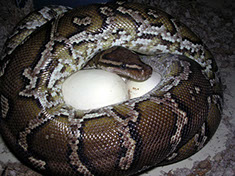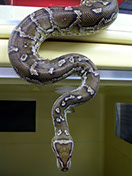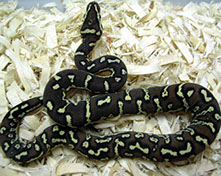

Angolan Python (Python achietae)
History and Growth
Angolan pythons are one of the most unique pythons available today. They are closely related to the Ball python, most notably by their terrestrial short heavy body, and head appearance. Angolans are indigenous to the Southwest African coast of Angola and Namibia. Until recently, they have been quite rare in collections. This is due to a long standing exportation ban from Africa. A war torn region which makes collecting a perilous endeavor at best. These circumstances have limited supply in the U.S. and as a result prices have been historically very high, limiting access to the average herp collector. Angolan pythons start out as brightly colored, robust babies--various shades of bright brown background, with random fluorescent yellow markings. Some display a limited pattern of bars across the dorsal, while others maintain a reduced pattern along the neckline with busy speckling. At this stage, Angolans’ most unique feature of beaded scales, feel more like soft grit sandpaper. As they grow beyond their first year, the scales enlarge and feel more like hundreds of beads or small bumps. Their coloration also transforms into shades of tan, brown, and cream. There are the occasional picky feeders, but they generally accept food without hesitation. Angolans will grow to 6 ft and remain very active and alert their whole lives.
Husbandry and Behavior
Of all the species we keep, Angolans are by far the most simple. Humidity levels are really not an issue. They do not appear to be affected by temperature spikes, one way or the other; so a standard ambient temp of 78-83F works fine. I find a hot spot is not necessary until winter approaches and NTL temps start to dip. At that point, I add a 24 hr red basking light. I have to believe their adaptability in captivity is in part due to the rugged terrain and temps in which they have evolved. They do well on aspen bedding, cypress mulch, or any other substrate that is safe for snakes. A hidebox is recommended as they are active, confident snakes, but do like the security of a hide at times.
Outlook and Collection
We've been working with a modest group of Angolan pythons since 2006. Over that time, we have had several successful breedings ranging from 6 to 13 eggs per clutch. We are also raising holdbacks to assure consistent production in the future. Our collection is mainly Lazik line genetics, with some older, unknown animals originating from Bushmaster. Our future goal is to acquire new animals from different, high quality bloodlines to add diversity to our colony. The market for Angolans has changed quite a bit. No longer do you have to look high and low to find them. No longer will you find them at a reptile expo for $10,000. However they still command a respectable price, which I believe is relatively stable. Market prices have dropped due to simple economics- increased supply. Perhaps the Ball python morph market has also had an effect. When hobbyists are looking for the latest, coolest morph, Angolans don't offer that. Those who work with them, do so for the privilege of keeping one of the most interesting and unique pythons in the world.





